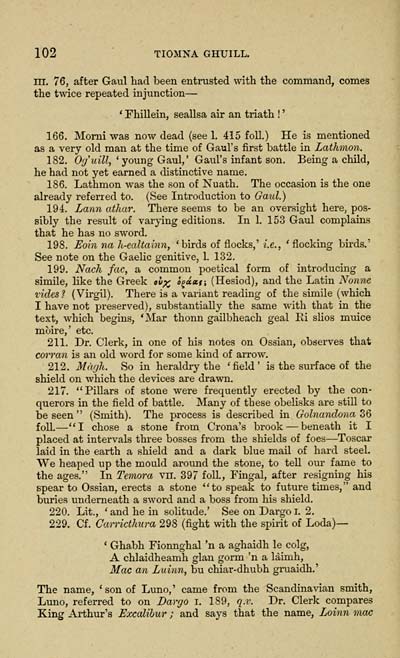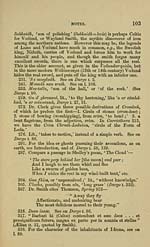Download files
Complete book:
Individual page:
Thumbnail gallery: Grid view | List view

102 TIOMNA GHUILL.
irr. 76, after Gaul had been entrusted with the command, comes
the twice repeated injunction —
* FhiUein, seallsa air an triath ! '
166. Momi was now dead (see 1, 415 foll.) He is mentioned
as a very old man at the time of Gaul's first battle in Lathmon.
182. Oguill, ' young Gaul,' Gaul's infant son. Being a child,
he had not yet eamed a distinctive name.
186. Lathmon was the son of Nuath. The occasion is the one
already referred to. (See Introduction to Gaul.)
194. Lann athar. There seems to be an oversight here, pos-
sibly the result of varying editious. In 1. 153 Gaul complains
that he has no sword.
198. Eoin na h-ealtainn, ' birds of flocks,' i.c, * flocking birds.'
See note on the Gaelic genitive, 1. 132.
199. Nach fac, a common poetical form of introducing a
simile, like the Greek ov;^ ò^uxf, (Hesiod), and the Latin Nonne
videsì (Virgil). There is a variant reading of the simile (which
I have not preserved), substantially the same with that in the
text, which begins, 'Mar thonn gailbheach geal Ki slios muice
mòire,' etc.
211. Dr. Clerk, in one of his notes on Ossian, observes that
corran is an old word for some kind of arrow.
212. Màrjh. So in heraldry the 'field' is the surf ace of the
shield on which the devices are drawn.
217. "Pillars of stone were frequently erected by the con-
querors in the field of battle. Many of these obelisks are still to
be seen " (Smith). The process is described in Golnandona o6
foU. — "I chose a stone from Crona's brook — beneath it I
placed at intervals three bosses from the shields of foes — Toscar
laid in the earth a shield and a dark blue maU of hard steel.
We heaped up the mould around the stone, to teU our fame to
the ages." In Temora vn. 397 folL, Fingal, after resigning his
spear to Ossian, erects a stone "to speak to future times," and
buries undemeath a sword and a boss from his shield.
220. Lit., 'and he in soUtude.' See on Dargo l. 2.
229. Cf. Carricthura 298 (fight with the spirit of Loda)—
' Ghabh Fionnghal 'n a aghaidh le colg,
A chlaidheamh glan gorm 'n a làimh,
Mac an Luinn, bu chiar-dhubh gruaidh.'
The name, 'sonof Luno,' came from the Scandinavìan smith,
Luno, referred to on Vargo i. 189, q.v. Dr. Clerk compares
King Arthur's Excalibur ; and says that the name, Loinn viac
irr. 76, after Gaul had been entrusted with the command, comes
the twice repeated injunction —
* FhiUein, seallsa air an triath ! '
166. Momi was now dead (see 1, 415 foll.) He is mentioned
as a very old man at the time of Gaul's first battle in Lathmon.
182. Oguill, ' young Gaul,' Gaul's infant son. Being a child,
he had not yet eamed a distinctive name.
186. Lathmon was the son of Nuath. The occasion is the one
already referred to. (See Introduction to Gaul.)
194. Lann athar. There seems to be an oversight here, pos-
sibly the result of varying editious. In 1. 153 Gaul complains
that he has no sword.
198. Eoin na h-ealtainn, ' birds of flocks,' i.c, * flocking birds.'
See note on the Gaelic genitive, 1. 132.
199. Nach fac, a common poetical form of introducing a
simile, like the Greek ov;^ ò^uxf, (Hesiod), and the Latin Nonne
videsì (Virgil). There is a variant reading of the simile (which
I have not preserved), substantially the same with that in the
text, which begins, 'Mar thonn gailbheach geal Ki slios muice
mòire,' etc.
211. Dr. Clerk, in one of his notes on Ossian, observes that
corran is an old word for some kind of arrow.
212. Màrjh. So in heraldry the 'field' is the surf ace of the
shield on which the devices are drawn.
217. "Pillars of stone were frequently erected by the con-
querors in the field of battle. Many of these obelisks are still to
be seen " (Smith). The process is described in Golnandona o6
foU. — "I chose a stone from Crona's brook — beneath it I
placed at intervals three bosses from the shields of foes — Toscar
laid in the earth a shield and a dark blue maU of hard steel.
We heaped up the mould around the stone, to teU our fame to
the ages." In Temora vn. 397 folL, Fingal, after resigning his
spear to Ossian, erects a stone "to speak to future times," and
buries undemeath a sword and a boss from his shield.
220. Lit., 'and he in soUtude.' See on Dargo l. 2.
229. Cf. Carricthura 298 (fight with the spirit of Loda)—
' Ghabh Fionnghal 'n a aghaidh le colg,
A chlaidheamh glan gorm 'n a làimh,
Mac an Luinn, bu chiar-dhubh gruaidh.'
The name, 'sonof Luno,' came from the Scandinavìan smith,
Luno, referred to on Vargo i. 189, q.v. Dr. Clerk compares
King Arthur's Excalibur ; and says that the name, Loinn viac
Set display mode to: Large image | Transcription
Images and transcriptions on this page, including medium image downloads, may be used under the Creative Commons Attribution 4.0 International Licence unless otherwise stated. ![]()
| Early Gaelic Book Collections > J. F. Campbell Collection > Dàn an Deirg agus Tiomna Ghuill (Dargo and Gaul) > (138) |
|---|
| Permanent URL | https://digital.nls.uk/77289176 |
|---|
| Description | Volumes from a collection of 610 books rich in Highland folklore, Ossianic literature and other Celtic subjects. Many of the books annotated by John Francis Campbell of Islay, who assembled the collection. |
|---|
| Description | Selected items from five 'Special and Named Printed Collections'. Includes books in Gaelic and other Celtic languages, works about the Gaels, their languages, literature, culture and history. |
|---|

